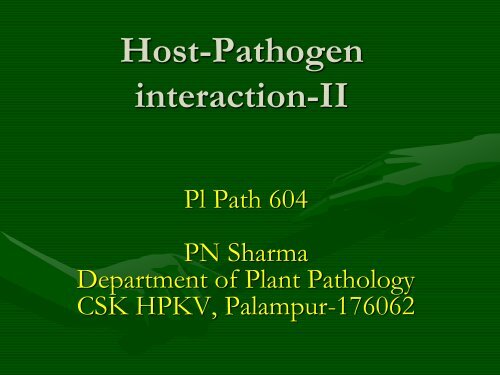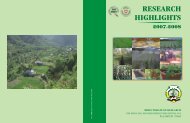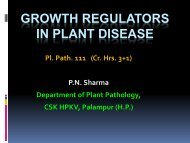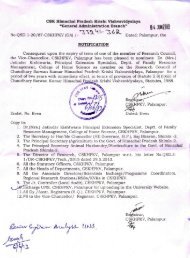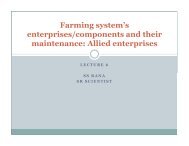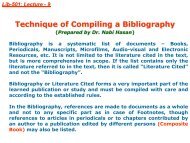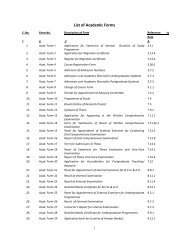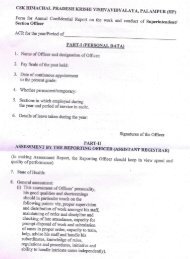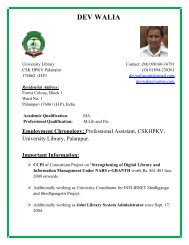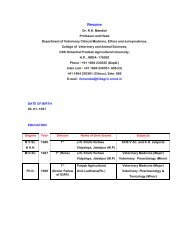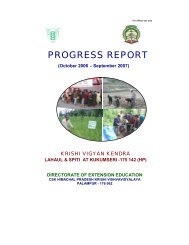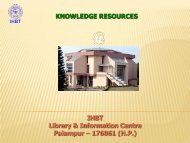Lect. 5 Host Pathogen interaction-II
Lect. 5 Host Pathogen interaction-II
Lect. 5 Host Pathogen interaction-II
You also want an ePaper? Increase the reach of your titles
YUMPU automatically turns print PDFs into web optimized ePapers that Google loves.
<strong>Host</strong>-<strong>Pathogen</strong><br />
<strong>interaction</strong>-<strong>II</strong><br />
Pl Path 604<br />
PN Sharma<br />
Department of Plant Pathology<br />
CSK HPKV, Palampur-176062
• It was originally believed that gene-for-gene resistance<br />
was conferred by a direct <strong>interaction</strong> between the R<br />
gene product and the Avr gene product, but<br />
experiments failed to show this.<br />
• Lack of evidence for a direct <strong>interaction</strong> indicated the<br />
involvement of some other type of <strong>interaction</strong> between<br />
the R gene and Avr gene products and this lead to the<br />
concept of indirect <strong>interaction</strong> models leading to<br />
resistance.
GUARD HYPOTHESIS<br />
Vander Biezen and Jones, 1998<br />
• lack of evidence for a direct <strong>interaction</strong><br />
indicated the involvement of some other type<br />
of <strong>interaction</strong> between the R gene and Avr<br />
gene products and led to the formation of the<br />
guard hypothesis.<br />
• This model proposes that the R proteins<br />
interact, or guard, a protein known as the<br />
guardee, which is the target of the Avr protein.<br />
When it detects interference with the guardee<br />
protein, it activates resistance.
Guard Hypothesis<br />
1. (A) A cellular complex of<br />
proteins (blue), which includes<br />
both the ‘guardee’ molecule<br />
(red) and a resistance gene<br />
2. (B) Binding of the effector to<br />
its target results in dissociation<br />
and activation of R-gene and<br />
thus disease resistance.<br />
3. (C) Alternatively, the R-gene<br />
may not be part of the target<br />
complex until effector binding.<br />
4. (D) Recruitment to the<br />
effector/target complex would<br />
then activate the R-gene.
Elicitor<br />
Target<br />
R-gene<br />
(Vander Biezen and Jones, 1998. Current Biology)
Support of guard model<br />
• No direct <strong>interaction</strong> is found between Ave<br />
factor and R proteins except shown in Avr ptopto<br />
and Avr pita-pita<br />
• Recognition of the Avr factor requires an<br />
additional host protein that is specific for each<br />
Ave-R pairs.<br />
• Structure of predicted function of this host<br />
protein, or its general occurrence, suggest that<br />
it might be a virulence target for the pathogen.
DIFFERENT INDIRECT MODELS TO<br />
SUPPORT GUARD HYPOTHESIS<br />
• Bridge : Effector binds independency to the<br />
R-protein into G the third protein, recruiting<br />
one to the other. The effector dependent<br />
<strong>interaction</strong> of these two proteins activates<br />
downstream signalling for defense.
R- protein<br />
Avr<br />
RESISTANCE<br />
Target<br />
protein<br />
(Source Martin et al., 2003. Annual Review of Plant Biology)
2. Matchmaker :<br />
• Effector induces a direct <strong>interaction</strong><br />
between R protein and a third protein by<br />
causing a conformational change in one or<br />
the other. The effector may or may not<br />
remains associated with the complex<br />
following binding CA two plant protein.
R<br />
Avr<br />
OR<br />
RESISTANCE<br />
Target protein<br />
(Source Martin et al., 2003. Annual Review of Plant Biology)
Affinity enhancement :<br />
• Interaction of the effector with the R-prtein a<br />
third protein or both, stabilizes a pre-existing,<br />
work <strong>interaction</strong> between the NO plant<br />
proteins such that abundance of the complex<br />
increase to drives dream signalling to activate<br />
the induced defense in steady state levels of<br />
<strong>interaction</strong> between the two plant proteins<br />
function to maintain basal defense.
Avr<br />
R<br />
OR<br />
RESISTANCE<br />
(Source Martin et al., 2003. Annual Review of Plant Biology)
De-repression :<br />
• Effector derepresser defense responses by<br />
disrupting an <strong>interaction</strong> of the R protein and a<br />
third protein that negatively regulates activity<br />
of the R protein.
Avr<br />
R<br />
Target protein<br />
And/ or<br />
RESISTANCE<br />
(Source Martin et al., 2003. Annual Review of Plant Biology)
Dual recognition<br />
• This model in which independent interactioins<br />
between the effector to the R gene and the<br />
effector a third protein are both required for<br />
resistance.
R<br />
Avr<br />
And<br />
RESISTANCE<br />
Target protein<br />
(Source Martin et al., 2003. Annual Review of Plant Biology)
RECENT EXAMPLES OF PLANT-PATHOGEN<br />
INTERACTIONS SUPPORTING GUARD HYPOTHESIS<br />
a. Arabidopsis RPM1 is a peripheral plasma membrane NB-<br />
LRR protein. It is activated by either the AvrRpm1 or the<br />
AvrB effector proteins. AvrRpm1 enhances the virulence<br />
of some P. syringae strains on Arabidopsis as does AvrB<br />
on soybeans. AvrRpm1 and AvrB are modified by<br />
eukaryote-specific acylation once delivered into the cell<br />
by the type <strong>II</strong>I secretion system (red syringe) and are thus<br />
targeted to the plasma membrane. The biochemical<br />
functions of AvrRpm1 and AvrB are unknown, although<br />
they target RIN4, which becomes phosphorylated (1P),<br />
and activate RPM1. In the absence of RPM1, AvrRpm1<br />
and AvrB presumably act on RIN4 and other targets to<br />
contribute to virulence. Light blue eggs in this and<br />
subsequent panels represent as yet unknown proteins.
Arabidopsis-P. syringae system<br />
( Source: Jones and dangl, 2006. Nature)
. RPS2 is an NB-LRR protein that resides at the<br />
plasma membrane. It is activated by the AvrRpt2<br />
cysteine protease type <strong>II</strong>I effector from P.<br />
syringae. Auto-processing of AvrRpt2 by a host<br />
cyclophilin reveals a consensus, but<br />
unconfirmed, myristoylation site at the new<br />
amino terminus, suggesting that it might also be<br />
localized to the host plasma membrane. AvrRpt2<br />
is the third effector that targets RIN4. Cleavage<br />
of RIN4 by AvrRpt2 leads to RPS2-mediated<br />
ETI. In the absence of RPS2, AvrRpt2<br />
presumably cleaves RIN4 and other targets as<br />
part of its virulence function.
C. RPS5 is an Arabidopsis NB-LRR protein localized<br />
to a membrane fraction, probably via acylation.<br />
RPS5 is NDR1-independent. It is activated by the<br />
AvrPphB cysteine protease effector from P.<br />
syringae. AvrPphB is cleaved, acylated and<br />
delivered to the host plasma membrane. Activated<br />
AvrPphB cleaves the Arabidopsis PBS1 serinethreonine<br />
protein kinase, leading to RPS5<br />
activation. The catalytic activity of cleaved PBS1 is<br />
required for RPS5 activation, suggesting that this<br />
‘modified-self’ fragment retains its enzymatic<br />
activity as part of the RPS5 activation mechanism.<br />
To date, no function has been ascribed to PBS1 in<br />
the absence of RPS5.
Arabidopsis-P. syringae system<br />
B. RPS2 is an NB-LRR protein that resides at the plasma<br />
membrane. It is activated by the AvrRpt2 cysteine<br />
protease type <strong>II</strong>I effector from P. syringae. Autoprocessing<br />
of AvrRpt2 by a host cyclophilin reveals a<br />
consensus, but unconfirmed, myristoylation site at the<br />
new amino terminus, suggesting that it might also be<br />
localized to the host plasma membrane. AvrRpt2 is the<br />
third effector that targets RIN4. Cleavage of RIN4 by<br />
AvrRpt2 leads to RPS2-mediated ETI. In the absence<br />
of RPS2, AvrRpt2 presumably cleaves RIN4 and other<br />
targets as part of its virulence function.
D. Pto is a tomato serinethreonine protein kinase.<br />
Pto is polymorphic and hence satisfies the genetic<br />
criteria for the definition of a disease resistance<br />
protein. Pto activity requires the NB-LRR protein<br />
Prf, and the proteins form a molecular complex.<br />
Prf is monomorphic, at least in the tomato species<br />
analysed to date. Pto is the direct target of two<br />
unrelated P. syringae effectors, AvrPto and<br />
AvrPtoB, each of which contributes to pathogen<br />
virulence in pto mutants. It is thus likely that Prf<br />
guards Pto. The Pto kinase is apparently not<br />
required for PTI, though there may be<br />
redundancy in its function because it is a member<br />
of a gene family.
Contd…<br />
Arabidopsis-P. syringae system<br />
(Source Jones and dangl, 2006)
Tomato – P. syringae system
E. The transmembrane RLP Cf-2 guards the<br />
extracellular cysteine protease Rcr3. Cf-2<br />
recognizes the C. fulvum extracellular<br />
effector Avr2, which encodes a cysteine<br />
protease inhibitor. Avr2 binds and inhibits<br />
the tomato Rcr3 cysteine protease.<br />
Mutations in Rcr3 result in the specific loss<br />
of Cf-2-dependent recognition of Avr2.<br />
Hence, Cf-2 seems to monitor the state of<br />
Rcr3, and activates defence if Rcr3 is<br />
inhibited by Avr2.
Tomato- C. Fulvum system<br />
Contd…<br />
(Source: Jones and dangl, 2006)


